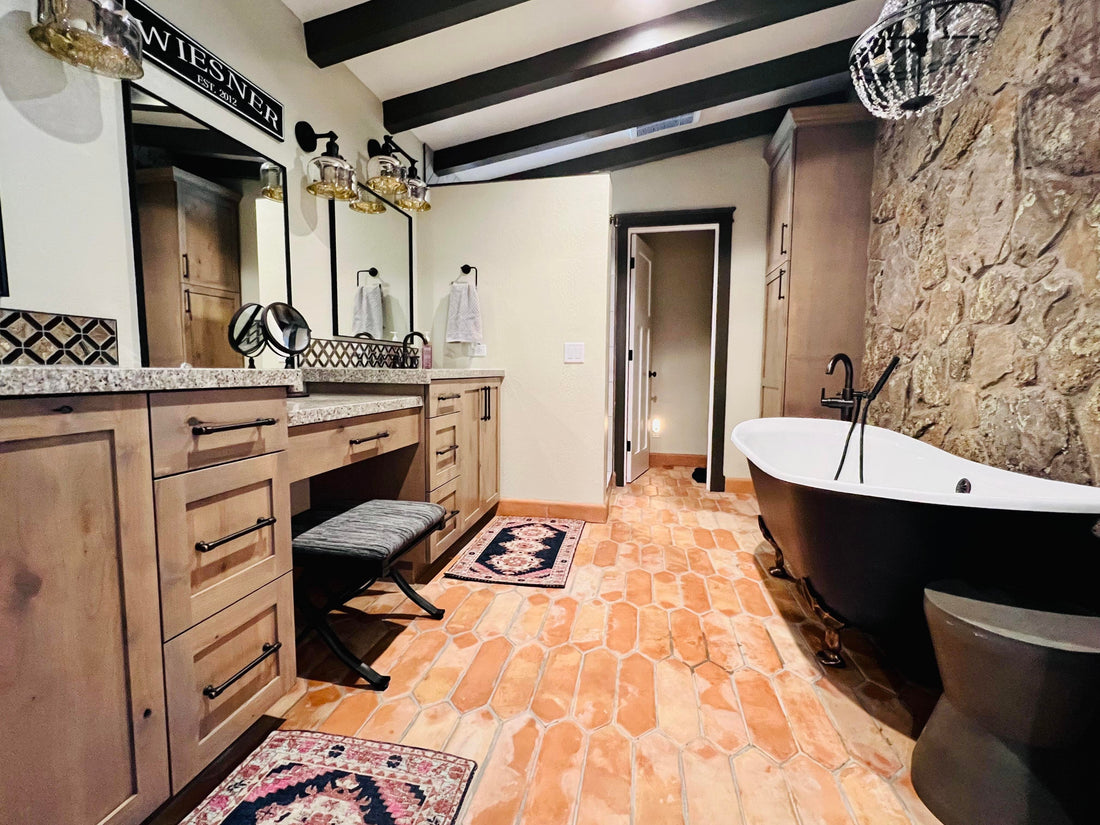
Saltillo Tile: A History & How to Care for Your Tile.
Saltillo tile is a type of clay tile that is commonly used in homes throughout Mexico and the southwestern United States. With its unique appearance and rustic charm, it has become a popular choice for homeowners looking to add a touch of traditional style to their homes. In this article, we will explore the history of Saltillo tile, how it is made, and how to install and care for this beautiful flooring option.
History of Saltillo Tile
Saltillo tile takes its name from the city of Saltillo in the northern Mexican state of Coahuila, where it has been produced for centuries. The tile is made from a type of clay that is found only in this region, which gives it its distinctive color and texture. Saltillo tile has been used in Mexican homes for centuries, and its popularity has spread to other parts of the world over the past few decades.
How Saltillo Tile is Made
Saltillo tile is made using a traditional process that has been passed down for generations. The clay is first dug up from the ground and then mixed with water to create a slurry. This mixture is poured into molds and left to dry in the sun for several days. Once the tiles are dry, they are fired in a kiln at high temperatures to harden them.
The firing process is what gives Saltillo tile its unique color variations. The tiles can range in color from a light yellow to a deep terra cotta, with shades of brown and red in between. The firing process also gives the tile its characteristic surface irregularities and rough texture.
How to Install Saltillo Tile
Installing Saltillo tile requires some experience with tile work. It is important to note that Saltillo tile is not as uniform as other types of tile, so it may take more time and effort to lay out a pattern. Here are the basic steps for installing Saltillo tile:
- Raw Saltillo tile must be sealed before installation. Due to the porous nature of the tile, it has the tendency to absorb liquid fast, and can create difficulty when cleaning grout lines during installation. Saltillo can be sealed using a chemical sealer or "Grout Release", or the traditional method of using a 50/50 blend of Boiled Linseed Oil and Paint Thinner. The oil method creates a satin finish on the Saltillo tile and brings out warmer colors.
-
Prepare the subfloor: The subfloor must be clean, level, and free of debris before installing Saltillo tile.
-
Lay out the pattern: Use a chalk line to mark the center of the room, and then lay out the pattern using dry tiles. Saltillo tiles are handmade, due to this, they are not uniform in shape or size. Using tile spacers will often result in uneven grout lines.
-
Apply the mortar: Spread a layer of mortar over a small section of the subfloor using a trowel.
-
Lay the tile: Place the tiles in the mortar, leaving a small gap between each one for grout.
-
Cut tiles as needed: Use a tile cutter or wet saw to cut tiles as needed to fit around the edges of the room.
-
Let the mortar dry: Allow the mortar to dry completely before grouting the tiles.
-
Grout the tiles: Mix grout according to the manufacturer's instructions, and use a grout float to apply it between the tiles.
-
Seal the tile: Once the grout has dried, apply a sealant to the tile to protect it from stains and moisture. We recommend using an an acrylic wax based sealer. Place of Clay currently uses Johnson Diversey products.
Caring for Saltillo Tile
Saltillo tile is a durable and long-lasting flooring option, but it does require some care to maintain its beauty. Here are some tips for caring for Saltillo tile:
- Clean regularly: Sweep or vacuum the tile regularly to remove dirt and debris. Avoid using a vacuum with a beater bar, as this can scratch the tile.
- Use a mild cleaner: Use a pH-neutral cleaner specifically designed for Saltillo tile to clean it. Avoid using harsh chemicals, as they can damage the tile.
- Seal the tile: Apply a sealant to the tile every year or two to protect it from stains and moisture.
- Avoid water damage: Saltillo tile is porous, so it can be damaged by water. Wipe up spills immediately to prevent them from seeping into the tile and causing damage. Use rugs or mats in areas where water may be present, such as in front of sinks or showers.
- Avoid heavy furniture: Saltillo tile is strong, but heavy furniture can crack or damage it. Use furniture pads or coasters to distribute the weight of heavy items.
- Repair cracks promptly: If you notice any cracks in the tile, repair them as soon as possible to prevent further damage. Fill the crack with grout or a patching compound, and then seal the tile to prevent future damage.
Conclusion
Saltillo tile is a beautiful and unique flooring option that has been used in homes for centuries. Its distinctive color and texture make it a popular choice for homeowners looking to add a touch of traditional style to their homes. By following the installation and care tips outlined in this article, you can ensure that your Saltillo tile flooring will look beautiful for many years to come.
Place of Clay specializes in importing authentic Saltillo tiles from Mexico. We carry one of the largest selections of styles and sizes on the market and offer as a service, a wide variety of finishes, including sealing and custom stains, so the tile arrives ready for installation. We can work to match existing tiles, or create the floor of your dreams. Contact us today to learn more!
